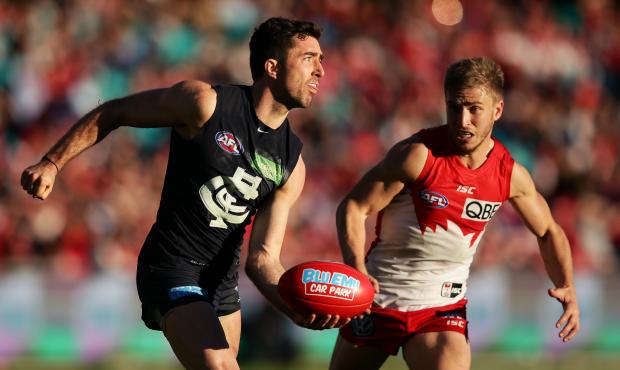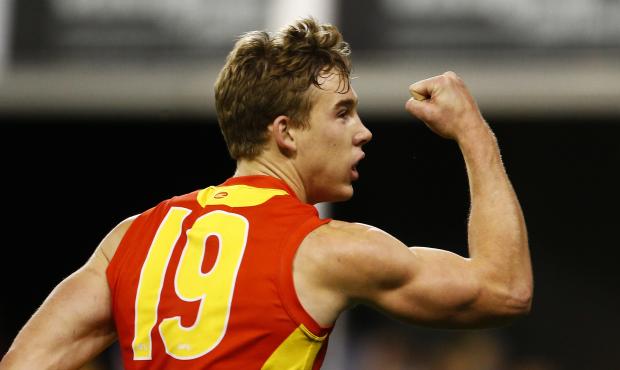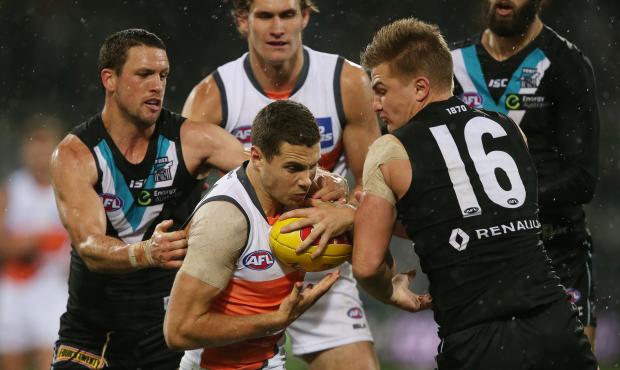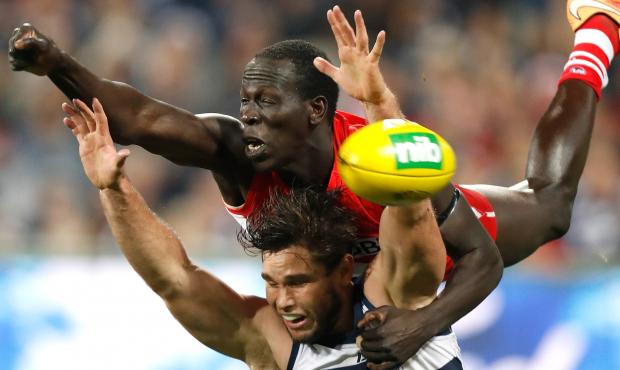
With one of the most dangerous attacks in the competition, it's no surprise the Crows were only team to convert over 50 per cent of their inside 50s last season. Eddie Betts (75), Josh Jenkins (62) and Taylor Walker (47) featured in the top-10 goalkickers in 2016, while Tom Lynch chimed in with a handy 42 majors for the year. The three big forwards in Jenkins, Walker and Lynch are a nightmare for any defender one out, when the ball is being sent forward quickly. - Nat Edwards

The Lions endured a 2016 season both the club and its fans would rather forget, but one thing they did well, given the opportunity, was score. Although being in the bottom four for total number of inside 50s, the Lions' forwards made the most of their chances, scoring almost every second time they went in there – good enough for second in the league. Similarly, when they won centre clearances, the Lions were excellent in transitioning the ball direct to a score – more than one in every four times, which ranked them first in the AFL. - Michael Whiting

2016 was a season of learning for the Blues under the tutelage of new coach Brendon Bolton. The ex-Hawthorn assistant took Carlton's young crop back to basics. The Blues looked for the short kick option more often than not under Bolton, and this saw an improvement in their disposal efficiency. Defenders Lachie Plowman, Kade Simpson and Zach Tuohy (now at Geelong) were Carlton's most efficient players, with the latter two the drivers behind setting up the Blues' offensive attack. - Nat Edwards
Veteran Kade Simpson was a driver of the Blues' offence last season. Picture: AFL Photos

When things weren't going well early last season, Collingwood's players were in the gun for a defensive structure that leaked like a sieve and for some horrendous turnovers. But the Pies tightened up defensively and tidied up their disposal as they gathered some momentum in the back half of the campaign. What the Magpies couldn't be accused of was a lack of effort, and their frenetic tackling intent has been a feature under Nathan Buckley in recent seasons. - Travis King

With 12 players missing the entire season through suspension, John Worsfold had to be adaptable in his first season in charge with Essendon, and his game-plan was clear. The Bombers' ranked first for uncontested marks as they tried to possess the ball for much of their games, and they had eight players take more than 100 marks for the season. The aerial prowess didn't stop at the uncontested work though, as the Bombers were also ranked fourth for marks taken in one-on-one contests. Just how Worsfold adjusts his tactics this season with a stronger team on the park will be fascinating. - Michael Whiting

Even without superstar Nat Fyfe and giant ruckman Aaron Sandilands for most of 2016, the Dockers still recorded a positive clearance differential, which bodes well for next season given the importance of stoppage wins to their previous success. Despite a horror year, it was no surprise that the Ross Lyon-coached outfit was still well-drilled in defensive aspects of the game, including tackling efficiency. - Travis King

The Cats rely on precision kicking to help sweep the ball from the backline to attack and capitalise on turnovers. However, with the introduction of superstar Patrick Dangerfield and ruckman Zac Smith last year, Geelong also became dominant at setting up scores from the centre square. Dangerfield in particular boosted the Cats' contested ball work, which became more of a focus for the team, and winning centre clearances helped Geelong lock the ball in their attacking half of the ground. - Travis King

Its team was depleted by injury for much of the season, but Gold Coast found a couple of nuggets of excitement from its 2016 campaign. New co-captain Tom Lynch earned his first All Australian selection and was a major reason behind the Suns being ranked fifth in the league for offensive one-on-one wins. Lynch took the most contested marks in the competition, and with second-season sidekick Peter Wright also in the top-30 in that category, they look to be a potent forward line duo that could become even more lethal with a fit midfield. - Michael Whiting
Tom Lynch took the most contested marks in the competition in 2016. Picture: AFL Photos

The Giants midfield is certainly the envy of a lot of opposition clubs. Clearance machines Stephen Coniglio, Callan Ward and Dylan Shiel all averaged around 5.5 clearances per game in 2016. Consequently, the Giants were the best side in the competition at turning stoppages into scoreboard pressure. Their quick ball movement made it extremely hard for teams to defend and you can expect they'll be at the top of this stat again this year. - Nat Edwards

For the last four seasons the Hawks have been renowned for their precision kicking and handball, and once again in 2016 they were at their best. That shouldn't change dramatically next season with their most efficient players Brendan Whitecross, James Frawley and Grant Birchall forming key planks of the best 22. Their forward line is also one of the most efficient in the competition with the Hawks scoring from one in every four inside-50 entries. The return of Jarryd Roughead in 2017 will only make their attack even more dangerous. - Nat Edwards

The Demons continued to improve in 2016 and became a more attacking unit. Midfielders Nathan Jones and Jack Viney were once again prolific for the red and blue, leading the way at the stoppages. But it was the rise of Clayton Oliver and Dom Tyson that helped pushed the Dees into the top echelon when it came to their work around stoppages. With more contributors too across the board, Melbourne's disposal differential was the second best in the competition, but they didn't always use it efficiently. The Dees were ranked 13th in disposal efficiency, and if they want to take another step forward this year, they need to improve this area significantly. - Nat Edwards

Robbie Tarrant's emergence as a genuine star backman had a significant bearing on the Roos' ability to curtail opposition marks inside their defensive 50 last season. Meanwhile, at the other end, the superb early form of Jarrad Waite plus Ben Brown's continued development gave North a potent aerial presence that should continue into 2017. - Travis King

When the Power lay tackles, they make sure they stick. Ollie Wines, Brad Ebert, Sam Gray and Travis Boak are not only among the most prolific tacklers in the competition, but also among the most effective. With a rate in excess of 70 per cent, Port led the league for tackling efficiency. Their defence also held up well when under attack, conceding goals less than a quarter of a time their opponents went inside 50, which ranked fourth. - Michael Whiting
Port, with Travis Boak and Ollie Wines, was the league's best for tackling efficiency. Picture: AFL Photos

In 2016, the Tigers were at their best when using the ball by foot. Led by Dustin Martin's career year, and another solid season from skipper Trent Cotchin, Richmond was second in the AFL for its kicking efficiency. That also extended to taking the ball inside 50, where almost a quarter of the Tigers' kicks finished with marks, which ranked them third in the league. How the departure of Brett Deledio and the acquisition of Dion Prestia and Josh Caddy affects this will be interesting to monitor. - Michael Whiting

With Josh Bruce, Tim Membrey and Paddy McCartin up forward – plus Nick Riewoldt regularly floating down from a wing – the Saints boasted one of the most lethal aerial lineups in the game last year, and it's little surprise nearly a quarter of kicks inside 50 found a marking target. St Kilda's frenetic pressure and ability to transition the ball in waves after a turnover excited the supporter base and has Alan Richardson's men primed for a top-eight assault. - Travis King

It's no surprise to see where the Swans were strong last season – defensively and in the contest. Led by Heath Grundy, Dane Rampe, Nick Smith and the emerging Aliir Aliir, Sydney conceded the fewest scores once the ball went inside its defensive 50. They also lost the third fewest defensive one-on-one contests. And with a midfield led by Josh Kennedy, Luke Parker and Dan Hannebery, the Swans again excelled around the clinches, ranking third in contested possession differential. - Michael Whiting
Aliir Aliir helped Sydney concede the fewest scores from inside 50 last season. Picture: AFL Photos

The Eagles have played a recognisable brand, especially on the narrow confines at Domain Stadium, which relies on winning clearances thanks to Nic Naitanui's dominance and then locking the ball inside their attacking half. That might have to be tinkered with after Naitanui's ACL injury. West Coast boasts a settled, talented and efficient forward line led by dual Coleman medallist Josh Kennedy, which is why the supply battle will continue to be crucial in 2017. - Travis King

The premiers were the contested ball kings in 2016. They averaged 16.5 more contested possessions than their opposition last year and this was the crux of their gameplan. Star Marcus Bontempelli lead the way in the category and was ably assisted by Liam Picken, Tom Liberatore, Luke Dahlhaus and Lachie Hunter. Given their hunger for contested ball, it's also no great surprise Luke Beveridge's men were the No.1 clearance team. The bullocking Bulldogs weren't afraid to get their hands dirty, and when they got the ball they moved it down the ground with precision and pace making them a dangerous force to reckon with. If they get this combination right again, and with a few key additions to their forward line, the Dogs could well salute again in 2017. - Nat Edwards



